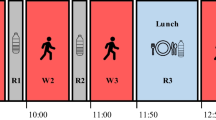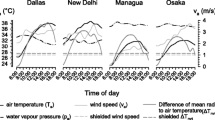Abstract
Purpose
The aim of this study was to analyze the physiological demands and thermal strain of wildland firefighters during real wildfire suppression.
Methods
The response of core temperature and heart rate (HR) were analyzed in 200 wildland firefighters during wildfire suppression activities of different duration: <1 h (n = 52), 1–3 h (n = 70), 3–5 h (n = 44), and >5 h (n = 34). The exercise workload (TRIMP), the physiological strain index (PSI), and cumulative heat strain index (CHSI) were calculated using the time spent in different intensity zones, the HR, and core temperature.
Results
Mean HR was significantly higher (P < 0.05) in wildfires <1 h (133 ± 2 bpm) and 1–3 h (128 ± 1 bpm) versus 3–5 h (120 ± 3 bpm) and >5 h (116 ± 32 bpm). The time spent in higher intensity zones increased (P < 0.05) when wildfire duration increased. TRIMP accumulation increased with wildfire duration (54.9 ± 3.2, 167.4 ± 5.9, 296.0 ± 8.3, 511.7 ± 12.8 in <1, 1–3, 3–5, and >5 h, respectively). Neither core temperature (37.4 ± 0.1°C) nor PSI (4.5 ± 0.2) were influenced by wildfire duration. The CHSI increased (p < 0.05) in the following order: <1 h (104 ± 23), 1–3 h (1,396 ± 275), 3–5 h (4,586 ± 387), and >5 h (10,703 ± 710).
Conclusions
The results demonstrate the high work strain sustained by Spanish wildland firefighters during wildfire suppression. Both workload and CHSI increased with the wildfires duration although the pace of work was faster in wildfires of a shorter duration.

Similar content being viewed by others
References
Achten J, Jeunkendrup AE (2003) Heart rate monitoring. Applications and limitations. Sports Med 33:517–538
American College Sports Medicine (1998) Position stand: the recommended quantity and quality of exercise for developing and maintaining cardiorespiratory and muscular fitness, and flexibility in healthy adults. Med Sci Sports Exerc 30:975–991
Angerer P, Kadlez-Gebhardt S, Delius M et al (2008) Comparison of cardio circulatory and thermal strain of male firefighters during fire suppression to exercise stress test and aerobic exercise testing. Am J Cardiol 102:1551–1556
Beaver WL, Wasserman K, Whipp BJ (1986) A new method for detecting the anaerobic threshold by gas exchange. J Appl Physiol 60:2020–2027
Billat VL, Lepretree PM, Heugas AM et al (2003) Training and bioenergetic characteristics in elite male and female Kenyan runners. Med Sci Sports Exerc 35:297–304
Bos J, Mol E, Visser B et al (2004) The physical demands upon (Dutch) fire-fighters in relation to the maximum acceptable energetic workload. Ergonomics 47:446–460
Brotherhood JR, Budd GM, Hendrie AL et al (1997a) Project aquarius 3. Effects of work rate on the productivity, energy expenditure, and physiological responses of men building fireline with a rakehoe in dry eucalypt forest. Int J Wildland Fire 7:87–98
Brotherhood JR, Budd GM, Hendrie AL et al (1997b) Project aquarius 11. Effects of fitness, fatness, body size, and age on the energy expenditure, strain, and productivity of men suppressing wildland fires. Int J Wildland Fire 7:181–199
Bruce RA (1971) Exercise testing of patients with coronary artery disease. Ann Clin Res 3:323–332
Budd GM (2001) How do wildland firefighters cope? Physiological and behavioural temperature regulation in men suppressing Australian summer bushfires with hand tools. J Therm Biol 26:381–386
Budd GM, Brotherhood JR, Hendrie AL et al (1997a) Project aquarius 4. Experimental bushfires, suppression procedures, and measurements. Int J Wildland Fire 7:99–104
Budd GM, Brotherhood JR, Hendrie AL et al (1997b) Project aquarius 7. Physiological and subjective responses of men suppressing wildland fires. Int J Wildland Fire 7:133–144
Byrne C, Lim CL (2007) The ingestible telemetric body core temperature sensor: a review of validity and exercise applications. Br J Sports Med 41:126–133
Byrne C, Lee JKW, Chew SAN et al (2006) Continuous thermoregulatory responses to mass-participation distance running in heat. Med Sci Sports Exerc 38:803–810
Cuddy JS, Gaskill SE, Sharkey BJ et al (2007) Supplemental feedings increase self-selected work output during wildfire suppression. Med Sci Sports Exerc 39:1004–1012
Cuddy JS, Ham JA, Harger SG et al (2008) Effects of an electrolyte additive on hydration and drinking behaviour during wildfire suppression. Wilderness Environ Med 19:172–180
Eglin CM, Tipton MJ (2005) Can firefighter instructors perform a simulated rescue after a live fire training exercise? Eur J Appl Physiol 95:327–334
Eglin CM, Coles S, Tipton J (2004) Physiological responses of fire-fighter instructors during training exercises. Ergonomics 47:483–494
Foster C, Florhaug JA, Franklin J et al (2001) A new approach to monitoring exercise training. J Strength Cond Res 15:109–115
Frank A, Belokopytov M, Shapiro Y et al (2001) The cumulative heat strain index: a novel approach to assess the physiological strain induced by exercise-heat stress. Eur J Appl Physiol 84:527–532
Hadid A, Yanovich R, Erlich T et al (2008) Effect of a personal ambient ventilation system on physiological strain during heat stress wearing a ballistic vest. Eur J Appl Physiol 104:311–319
Heil DP (2002) Estimating energy expenditure in wildland fire fighters using a physical activity monitor. Appl Ergon 33:405–413
Hostler D, Gallagher M Jr, Goss FL et al (2009) The effect of hyperhydration on physiological and perceived strain during treadmill exercise in personal protective equipment. Eur J Appl Physiol 105:607–613
Laursen PB, Suriano R, Quod MJ et al (2006) Core temperature and hydration status during an ironman triathlon. Br J Sports Med 40:320–325
Lucía A, Hoyos J, Santalla A et al (2003) Tour de France versus Vuelta a España: which is harder? Med Sci Sports Exerc 35:872–878
McKenzie JE, Osgood DW (2004) Validation of a new telemetric core temperature monitor. J Therm Biol 29:605–611
Montain SL, Sawka MN, Cadarette BS et al (1994) Physiological tolerance to uncompensable heat stress: effects of exercise intensity, protective clothing, and climate. J Appl Physiol 77:216–222
Moran DS, Shitzer A, Pandolf KB (1998) A physiological strain index to evaluate heat stress. Am J Physiol Regul Inegr Comp Physiol 275:R129–R134
Petruzzello SJ, Gapin JI, Snook E et al (2009) Perceptual and physiological heat strain: examination in firefighters in laboratory- and field based studies. Ergonomics 52:747–754
Richmond VL, Rayson MP, Wilkinson DM et al (2008) Physiological demands of firefighter search and rescue in ambient environmental conditions. Ergonomics 51:1023–1031
Rodríguez-Marroyo JA, García-López J, Juneau CE et al (2009) Workload demands in professional multi-stage cycling races of varying duration. Br J Sports Med 43:180–185
Ruby BC, Shriver TC, Zderic TW et al (2002) Total energy expenditure during arduous wildfire suppression. Med Sci Sports Exerc 34:1448–1454
Smith DL, Manning TS, Petruzzello SJ (2001) Effect of strenuous live-fire drills on cardiovascular and psychological responses of recruit firefighters. Ergonomics 44:244–254
Takken T, Ribbink A, Heneweer H et al (2009) Workload demand in police officers during mountain bike patrols. Ergonomics 52:245–250
Tikuisis P, McLellan TM, Selkirk G (2002) Perceptual versus physiological heat strain during exercise-heat stress. Med Sci Sports Exerc 34:1454–1461
von Heimburg ED, Rasmussen AK, Medbo JI (2006) Physiological responses of firefighters and performance predictors during a simulated rescue of hospital patients. Ergonomics 49:111–126
Wegesser TC, Pinkerton KE, Last JA (2009) California wildfires of 2008: coarse and fine particulate matter toxicity. Environ Health Perspect 117:893–897
Wu HC, Wang MJJ (2001) Determining the maximum acceptable work duration for high-intensity work. Eur J Appl Physiol 85:339–344
Acknowledgments
This work has been funded by Empresa de Transformación Agraria, SA. (TRAGSA), Mutua Fraternidad–Muprespa and Empresa de Gestión Medioambiental, SA. (EGMASA). This study was conducted with the collaboration of the Área de Defensa contra Incendios Forestales, Dirección General de Medio Natural y Política Forestal, Ministerio de Medio Ambiente y Medio Rural y Marino, Spain.
Conflict of interest
The authors declare that they have no conflict of interest.
Author information
Authors and Affiliations
Corresponding author
Rights and permissions
About this article
Cite this article
Rodríguez-Marroyo, J.A., López-Satue, J., Pernía, R. et al. Physiological work demands of Spanish wildland firefighters during wildfire suppression. Int Arch Occup Environ Health 85, 221–228 (2012). https://doi.org/10.1007/s00420-011-0661-4
Received:
Accepted:
Published:
Issue Date:
DOI: https://doi.org/10.1007/s00420-011-0661-4




